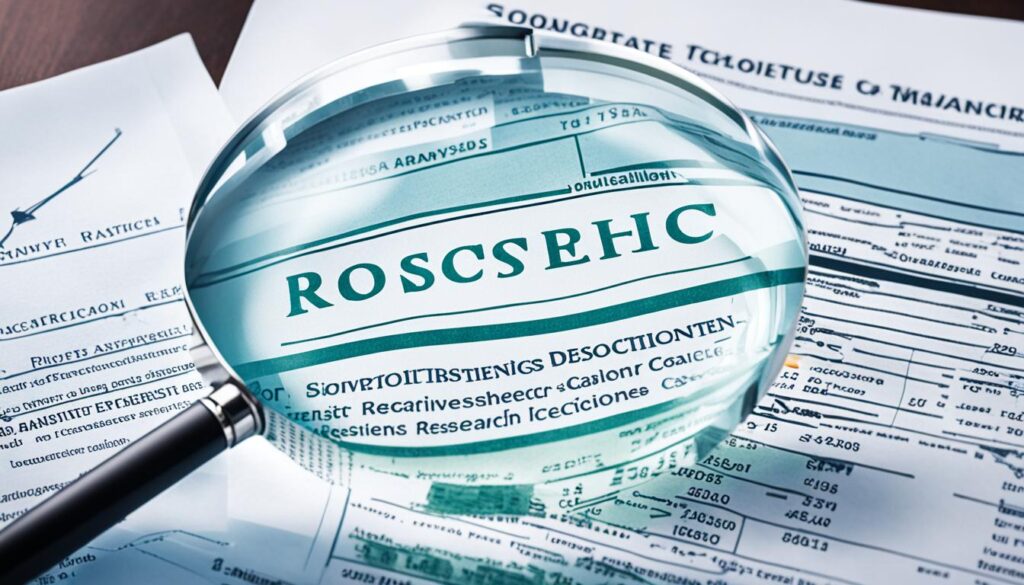Are you aware that private placement investing is a valuable strategy for retirement planning? By potentially achieving higher returns and diversifying your portfolio, private placements provide an alternative investment option for self-directed Individual Retirement Accounts (IRAs).
By establishing a self-directed IRA, you can gain access to a wider range of investment opportunities, including private equity investments. This guide will provide valuable insights into investing in private placements with a self-directed IRA, exploring the types of investments available, the rules and considerations involved, and the steps to get started.
Key Takeaways:
- Private placement investing can be a powerful strategy for retirement planning with a self-directed IRA.
- Self-directed IRAs offer access to a wider range of investment options, including private equity investments.
- Investing in private placements requires understanding the rules, conducting due diligence, and seeking professional advice.
- By carefully considering your investment objectives and risk tolerance, you can optimize your retirement planning strategy.
- Choosing a reliable custodian is crucial for effectively managing your self-directed IRA.
Investing in Private Placement with a Self-Directed IRA
Investing in private placement with a self-directed IRA provides individuals with a unique avenue for pursuing alternative investments. In a recent webinar hosted by The Entrust Group, they shed light on the numerous benefits and detailed the process of utilizing self-directed IRAs in private placement investing. The webinar covered an array of topics, including the various types of self-directed accounts available, investment options, due diligence best practices, and the step-by-step process of investing in private placement using a self-directed IRA.

“Investing in private placement with a self-directed IRA allows individuals to diversify their portfolios and discover unique investment opportunities.”
Private placement investing with a self-directed IRA grants access to a wide range of alternative investment options, such as privately-held companies, hedge funds, limited partnerships, and real estate investment trusts (REITs). These investments offer individuals the freedom to explore different avenues for potential growth outside of traditional investment options.
By leveraging a self-directed IRA, individuals can exercise greater control over their retirement funds and explore alternative investment possibilities that align with their financial goals and risk tolerance. With a self-directed IRA, investors have the freedom to select and direct the investments, allowing for a personalized investment strategy.
Types of Alternative Investments
When investing in private placement with a self-directed IRA, individuals have a multitude of alternative investment options to choose from. These include:
| Alternative Investments | Description |
|---|---|
| Private Equity | Investing in privately owned businesses or funds |
| Real Estate | Investing in rental properties, commercial properties, or REITs |
| Private Debt | Investing in privately issued loans or debt securities |
| Private Placements | Investing in companies that are not publicly traded |
| Startups | Investing in early-stage companies |
These alternative investment options offer the potential for higher returns, diversification, and exposure to different sectors of the market.
Utilizing a self-directed IRA for private placement investing enables individuals to tap into a diverse range of opportunities outside the traditional stock and bond markets. However, it is crucial to conduct thorough due diligence and engage in careful research when selecting these alternative investment options. This ensures investors are making well-informed decisions that align with their financial objectives.
Next, we will explore the specific rules and considerations associated with private placements and self-directed IRAs, shedding light on the intricacies of this investment strategy.
Private Equity Investments with Self-Directed IRAs
Private equity investments with self-directed IRAs offer account holders the opportunity to focus on privately owned assets in businesses. With a self-directed IRA, individuals have control over their investment portfolio and can choose to invest directly in a company or through a pooled investment vehicle or fund.
This investment strategy provides several benefits. First, it offers control and flexibility, allowing investors to actively manage their portfolio and make investment decisions based on their own research and assessment. This level of control ensures that the investment aligns with their long-term retirement saving goals.
Additionally, private equity investments with self-directed IRAs offer access to a wider range of investment opportunities, including alternative investments not typically available in traditional retirement accounts. This diversification can potentially lead to higher returns and reduced risk through exposure to different asset classes.
“Private equity investments with self-directed IRAs offer control, flexibility, diversification, and potential for higher returns.”
Furthermore, private equity investments with self-directed IRAs provide tax advantages. As the investments are made through the IRA, any gains or income generated from these investments can be tax deferred or tax-free, depending on the type of account.
Overall, private equity investments with self-directed IRAs can be an attractive option for investors looking to take a more active role in their retirement planning. By leveraging their investment control and exploring a broader range of investment opportunities, individuals can potentially enhance their portfolio performance and work towards their long-term financial goals.

Benefits of Private Equity Investments with Self-Directed IRAs:
- Control and flexibility over investment choices
- Diversification within the portfolio
- Access to alternative investments
- Potential for higher returns
- Tax advantages
- Alignment with long-term retirement saving goals
Rules and Considerations for Private Placements with SDIRAs
When investing in private placements with self-directed IRAs, it is important to understand the rules and considerations in order to make informed decisions. Compliance with SEC requirements, conducting due diligence, and adhering to certain restrictions are crucial aspects of the investment process.
SEC Requirements for Private Placements
Private placements are exempt from registration and reporting requirements imposed by the Securities and Exchange Commission (SEC). However, it is important to note that investors must meet the accreditation criteria established by the SEC. This means that individuals must have a certain level of income or assets to qualify for private placements.
Due Diligence
Due diligence plays a vital role in mitigating risks associated with private placements. Investors should thoroughly research potential investments, review offering documents, and seek professional advice when necessary. This comprehensive analysis helps identify potential red flags, evaluate the investment’s viability, and assess the risks involved.
Restrictions and Considerations
Investing in private placements with self-directed IRAs also involves a set of restrictions and considerations. Some of these include:
- Restrictions on purchasing private stock already owned: It is important to note that self-directed IRAs cannot purchase private stock that the account holder already owns outside of the IRA. This ensures compliance with IRS regulations.
- Limitations on employment with the company: Investing in a private placement cannot involve employment with the company where the funds are being invested. This limits potential conflicts of interest and ensures impartial investment decision-making.
- Ownership of equity and payment of fees and costs: The self-directed IRA owns the equity in the investment, and all expenses related to the investment, such as fees and costs, are paid by the IRA.
By following these rules and considerations, investors can navigate the complexities of private placements with self-directed IRAs effectively.
| Rules and Considerations | Description |
|---|---|
| SEC Requirements | Investors must meet accreditation criteria imposed by the SEC to participate in private placements. |
| Due Diligence | Conduct comprehensive research and assessment of investment opportunities to minimize risks. |
| Restrictions on purchasing private stock already owned | Self-directed IRAs cannot buy private stock already owned outside of the IRA. |
| Limitations on employment with the company | Investors cannot be employed by the company in which the funds are being invested. |
| Ownership of equity and payment of fees and costs | The self-directed IRA owns the equity and pays for investment-related expenses. |

Types of Private Equity Investments with SDIRAs
Private equity investments with self-directed IRAs provide investors with a wide range of options to diversify their portfolios and potentially achieve higher returns. These investments offer the opportunity to invest in various asset classes, including:
- Private Stock: Investing in privately held companies allows SDIRA holders to participate in the growth and success of these businesses.
- Hedge Funds: Privately held hedge funds offer sophisticated investment strategies and potential for higher returns.
- Limited Partnerships: SDIRA owners can invest in limited partnerships to gain exposure to different industries and share in the profits.
- Limited Liability Companies (LLCs): Investing in LLCs through SDIRAs provides flexibility and control over the investment.
- Real Estate Investment Trusts (REITs): REITs allow investors to participate in the real estate market without directly owning properties.
Aside from these commonly known private equity investments, there are also other avenues for SDIRA holders to explore:
- Small businesses
- Startups
- Partnerships
- Corporations
- Equity crowdfunding
- Convertible notes
- Franchises
- Land trusts
By diversifying their SDIRA portfolios with these private equity investments, investors can strategically allocate their retirement funds, aiming for long-term growth and potentially higher returns.
Advantages of Different Private Equity Investments
Each type of private equity investment with SDIRAs offers unique advantages:
| Type of Investment | Advantages |
|---|---|
| Private Stock | Opportunity to invest in private companies and potentially benefit from their growth and success |
| Hedge Funds | Potentially higher returns and access to sophisticated investment strategies |
| Limited Partnerships | Opportunity to invest in different industries and share in the profits |
| Limited Liability Companies (LLCs) | Control and flexibility over investment decisions |
| Real Estate Investment Trusts (REITs) | Participation in the real estate market without direct property ownership |

Investors should carefully evaluate each type of private equity investment, considering their risk tolerance, investment goals, and long-term retirement planning strategy. Consulting with financial advisors and conducting thorough due diligence is essential to make informed investment decisions.
Benefits of Private Equity Investments with SDIRAs
Private equity investments with self-directed IRAs offer a range of advantages for savvy investors seeking to diversify their portfolios and achieve long-term financial goals. Let’s explore the key benefits of private equity investments with SDIRAs:
- Control and Flexibility: With self-directed IRAs, investors have full control over their investment choices, allowing them to actively participate in decision-making processes. This level of control empowers individuals to tailor their investment strategy according to their risk tolerance, financial objectives, and personal circumstances.
- Diversification: Private equity investments present an opportunity to diversify one’s investment portfolio beyond traditional asset classes like stocks and bonds. By allocating funds to private equity investments, investors can spread their risk across different sectors, industries, and strategies, helping to mitigate potential losses and increase the potential for gaining attractive returns.
- Access to Alternative Investments: Self-directed IRAs provide access to a wide range of alternative investments, such as venture capital, private equity funds, real estate partnerships, and more. These alternative investments often have the potential for higher returns compared to conventional investment options, offering investors the chance to tap into unique opportunities and potentially enhance their overall portfolio performance.
- Potential for Higher Returns: Private equity investments have historically delivered strong returns compared to traditional investments. By investing in privately owned businesses or funds, individuals may benefit from the growth and success of these ventures, potentially generating significant capital appreciation and income over the long term.
- Tax Advantages: Private equity investments made through self-directed IRAs can provide tax advantages. Depending on the structure of the investment and specific tax regulations, investors may enjoy benefits such as tax deferral, tax-free growth, and potential tax deductions, ultimately optimizing their investment returns and minimizing tax liabilities.
- Long-Term Investment Focus: Private equity investments are typically seen as long-term commitments. This aligns well with the goal of retirement planning, as individuals can take advantage of the compounding effect over an extended period. By choosing carefully structured private equity investments, investors can optimize their retirement savings and work towards achieving their long-term financial objectives.
To illustrate the benefits of private equity investments with SDIRAs further, let’s take a look at the following example:
“Investing in private equity through a self-directed IRA allowed John to diversify his retirement portfolio with investments in startup companies, real estate partnerships, and private equity funds. This enabled him to participate in exciting ventures and potentially generate higher returns compared to traditional investments. Furthermore, John appreciated the control and flexibility he had over his investment decisions, allowing him to align his investment strategy with his risk tolerance and long-term financial goals.”

Steps for Investing in Private Placement with a SDIRA
Investing in private placement with a self-directed IRA involves several steps. By following these steps, you can make informed decisions and optimize your investment strategy.
Create a Self-Directed IRA with a Reliable Custodian
The first step is to establish a self-directed IRA with a trustworthy custodian. Choose a custodian that specializes in self-directed IRAs and has experience in private placement investments. A reliable custodian will provide the necessary guidance and support throughout the investment process.
Roll Over Funds from Retirement Plans or Transfer Funds from an Existing IRA
Once you have a self-directed IRA, you can transfer funds from an existing IRA or roll over funds from retirement plans such as 401(k)s or 403(b)s. This step allows you to consolidate your retirement savings and have the funds available for private placement investments.
Instruct Your Self-Directed IRA Custodian to Invest
After funding your self-directed IRA, the next step is to instruct your custodian to invest in your preferred private equity investment. Provide the necessary information and instructions to your custodian, who will then facilitate the investment on behalf of your IRA.
Following these steps ensures that you have a well-established self-directed IRA and have taken the necessary actions to invest in private placement opportunities. By working with a reliable custodian, consolidating your funds, and providing instructions, you can navigate the process smoothly and make sound investment decisions for your retirement. This proactive approach empowers you to take control of your financial future while exploring diverse investment options tailored to your goals. With careful planning and due diligence, you can achieve financial freedom through retirement planning, securing the lifestyle you envision for your golden years. Remember, a well-structured strategy today sets the foundation for lasting financial stability tomorrow.

Considerations Before Investing in Private Placement with a SDIRA
Before embarking on private placement investing with a self-directed IRA (SDIRA), it is essential to consider a few crucial factors to make informed investment decisions. These considerations will help align your investment objectives and risk tolerance with the opportunities presented by private placements.
1. Identify Investment Objectives
Begin by clearly defining your investment objectives. Are you seeking long-term growth, income generation, or a combination of both? Understanding your objectives will help you evaluate private placement opportunities that align with your desired investment outcomes.
2. Assess Risk Tolerance
It is equally vital to assess your risk tolerance before investing in private placements with an SDIRA. Private placement investments can carry higher risks compared to traditional investment options. Evaluate your comfort level with market volatility, illiquidity, and the potential for loss.
3. Conduct Thorough Due Diligence
Prioritize conducting thorough due diligence on potential private placement opportunities. Research the issuer’s track record, financials, industry trends, and competitive landscape. Evaluate the investment’s viability, potential returns, and associated risks.
“Due diligence is the foundation of successful private placement investing. Take the time to conduct extensive research and analysis to uncover the potential and risks of each investment opportunity.”
4. Seek Professional Advice
Consider seeking advice from financial, tax, and legal professionals who specialize in SDIRA investments. They can provide valuable insights and help navigate the complex regulations and tax implications associated with private placements. Their expertise can ensure you make well-informed decisions aligned with your financial goals.
5. Choose an Experienced Custodian
Selecting the right custodian for your SDIRA is crucial. An experienced custodian can offer guidance, assistance in managing your assets, and ensure compliance with IRS regulations. Choose a custodian with a strong track record of facilitating private placement investments to benefit from their expertise and support.
By carefully considering your investment objectives, conducting thorough due diligence, seeking professional advice, and choosing an experienced custodian, you can confidently navigate the world of private placement investing with an SDIRA. Making informed decisions will help you maximize potential returns while managing risks effectively.

| Benefits of Considerations | Private Placement with SDIRA |
|---|---|
| Alignment with Investment Objectives | ✔️ |
| Mitigation of Risks | ✔️ |
| Confident Decision-Making | ✔️ |
| Compliance with Regulations | ✔️ |
Conclusion
Private placement investing with a self-directed IRA offers individuals the opportunity to diversify their portfolios and potentially achieve higher returns. By understanding the rules surrounding private placements with SDIRAs and considering different types of private equity investments, investors can make informed decisions and optimize their retirement planning strategy.
Successful private placement investing requires diligent research and due diligence on potential investment opportunities. Seeking professional advice from financial, tax, and legal experts can provide valuable insights and guidance in navigating this complex investment landscape.
Furthermore, selecting a reliable and experienced custodian to manage self-directed IRAs is crucial to ensure compliance and transparency throughout the investment process. With careful planning and consideration, individuals can leverage the power of private placement investing to enhance their retirement planning goals and secure their financial future.











